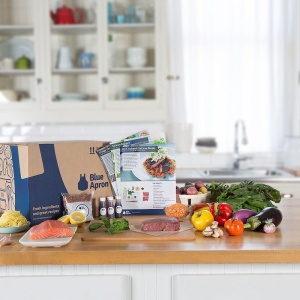
This paper calculates the environmental impacts (climate change, acidification, eutrophication, land use, and water use) caused by either making a meal by using a meal kit (which contains pre-portioned ingredients for cooking a meal) or by buying the ingredients from a grocery store.
The paper assesses five different meal types (salmon, cheeseburger, chicken, pasta, and salad). The life cycle assessment encompasses production and disposal of both food and packaging materials.
It finds that meal kits use more packaging than grocery-bought ingredients, but also produce less food waste because the kits only supply the amount of ingredients necessary to make one meal to the customer. In contrast, ingredients bought at a grocery store generally have to be purchased in quantities larger than that required for one meal. The study distinguishes between food waste that is discarded, and leftovers that are eventually consumed on a separate occasion. The impacts of cooking the meal and the leftovers (either a portion of the prepared meal, or a fraction of the unused raw ingredients that are prepared as a different meal on a separate occasion) were allocated between the two on the basis of mass.
The two supply chains are also different in that the ingredients from the grocery store are transported from the retail store to the consumer’s residence with a private consumer vehicle, whereas meal kits are delivered directly from the producer to the consumer using a delivery truck.
For four out of five meal types, the grocery store meal produced higher greenhouse gas emissions than the meal kit, as shown in the figure below. Life cycle assessment results for the other four impact categories are provided in the supplementary data for the paper.
 Image: Figure 2, Heard et al. Total estimated emissions (kg CO2e) for the five meals studied supplied as a meal kit or via a grocery store. Black lines indicate median emissions for each meal by type, and boxes indicate emissions within the 25th and 75th percentiles of model runs. Grey dots indicate values falling outside of this range, which may be considered outliers. These more-extreme values have an upward bias, reflecting higher-emissions intensity cases to create, supply, and consume meals.
Image: Figure 2, Heard et al. Total estimated emissions (kg CO2e) for the five meals studied supplied as a meal kit or via a grocery store. Black lines indicate median emissions for each meal by type, and boxes indicate emissions within the 25th and 75th percentiles of model runs. Grey dots indicate values falling outside of this range, which may be considered outliers. These more-extreme values have an upward bias, reflecting higher-emissions intensity cases to create, supply, and consume meals.
Abstract
Meal kits contain ingredients for cooking a meal that are pre-portioned, packaged, and delivered to a consumer’s residence. Life cycle environmental impacts associated with climate change, acidification, eutrophication, land use, and water use are compared for five dinner recipes sourced as meal kits and through grocery store retailing. Inventory data are obtained from direct measurement of ingredients and packaging, supplemented with literature data for supply chain and production parameters. Results indicate that, on average, grocery meal greenhouse gas emissions are 33% higher than meal kits (8.1 kg CO2e/meal compared with 6.1 kg CO2e/meal kit). Other impact categories follow similar trends. A Monte Carlo analysis finds higher median emissions for grocery meals than meal kits for four out of five meals, occurring in 100% of model runs for two of five meals. Results suggest that meal kits’ streamlined and direct-to-consumer supply chains (−1.05 kg CO2e/meal), reduced food waste (−0.86 kg CO2e/meal), and lower last-mile transportation emissions (−0.45 kg CO2e/meal), appear to be sufficient to offset observed increases in packaging (0.17 kg CO2e/meal). Additionally, meal kit refrigeration packs present an average emissions decrease compared with retail refrigeration (−0.37 kg CO2e/meal). Meals with the largest environmental impact either contain red meat or are associated with large amounts of wasted food. The one meal kit with higher emissions is due to food mass differences rather than supply chain logistics. Meal kits are an evolving mode for food supply, and the environmental effects of potential changes to meal kit provision and grocery retailing are discussed.
Reference
Heard, B.R., Bandekar, M., Vassar, B. and Miller, S.A. (2019). Comparison of Life Cycle Environmental Impacts from Meal Kits and Grocery Store Meals. Resources, Conservation and Recycling, In press, corrected proof.
Read the full paper here. See also the Foodsource resource The value and limitations of lifecycle assessment.







Post a new comment »